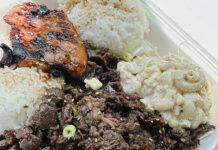
Story by Bill Finch • Pea info by Amelia Rose Zimlich • Photos by Elizabeth Gelineau
It was one of the few activities that could unite this contentious confederacy that we call the South. Democrats and Republicans, black hands and white hands, folks who went to mass, synagogue or Wednesday evening prayer meetings and the ones who didn’t go at all – they all shelled peas.
Peas were our good fortune, sometimes our only good fortune. Shelling them was as good as counting money. My great-grandmother shelled peas at a prize-winning clip, zipping the string, sliding her wrinkled thumb up the pod — and pling, pling, pling, jackpot — a row of peas rattled into the colander. It was the music of a summer evening.
We sat on stumps to shell peas. Crude benches. Porch steps. Wooden rockers. Aluminum folding chairs with striped green webbing. A colleague once told me the story of how grandmothers and aunts sat in the fluorescent hallway of the hospital, quietly shelling peas until her birth was announced.
The ability to shell peas was a mark of being raised right. My mother has been nothing but enthusiastic about her grandson’s new girlfriend: She’s smart, pretty and polite. But, my mother confided to me the other day, the poor girl doesn’t know a thing about shelling peas.
If you’re more than a few decades old, and you grew up in the South, I don’t have to explain to you that I’m not talking spring peas, green peas or English peas. We’re referring, instead, to those pea-like beans some carelessly put off as cowpeas or field peas, but which are better characterized as Southern peas, and which, in knowledgeable households below the Mason-Dixon, need no elaboration beyond simply “peas.”
The Southern pea is finding a new appreciation nationally. It’s showing up more often in fine restaurants up North and out West. But down here in Dixie, the tradition is on the wane, and it has been unfortunately reduced in the popular imagination to the “black-eyed pea” — a pre-shelled, pre-packaged commercial abomination that bears little resemblance to the real thing.
Way back when, traditional gardeners and Southern cooks had far finer (and better adapted) peas to choose from, like the pinkeye purple hulls; piebald peas, like Calico or Polecat; meaty brown crowders with their deep, dark liquor; bird’s egg peas (with delicate speckling), like Whippoorwill or Blue Goose; south Louisiana’s elegant jet black crowders; Red Ripper and Mississippi Silver; pale and creamy-flavored Running Conch and Zipper Cream; or those exquisitely tiny and fiddly Lady peas.
There were so many different kinds of peas, it’s misleading to name so few. They were the genuine heirloom vegetables: A hundred years ago, most serious gardening families could claim their own strains of peas, ideally suited to their garden, eating habits and tastes.
Every year, someone offers me an old strain with a quaint name, like Preacher peas or Longhorn peas. I ought to grow them, lest we lose more of our genuine Southern heritage. But I can preserve only one at a time, and I’m responsible for an old variety from southeast Mississippi.
It doesn’t have a name, so I call it Ray and Bertice peas, remembering the friends who gave it to me.
The truth is, I haven’t planted them in more than a decade. They love where they are so much that they keep reseeding themselves, producing bushels of peas even among the brush and weeds. I don’t so much cultivate them as police them.
That’s one of the reasons Southern peas and their relatives — originally from the tropics of West Africa — have become so popular anywhere the summers are long and the nights are warm. They romp through our heat and humidity, even as they stumble in the cool, short summers of Europe and New England.
Maybe you have to work up a sweat to really appreciate what peas have to offer. But, fresh peas over cornbread with creamed corn and tomatoes are one of those delicacies that, once eaten, can make paradise seem superfluous.
First, of course, you have to shell them. Only those who haven’t tried it will find it to be a chore. We all have modern rituals to still our souls. Momma goes to yoga, Daddy goes to golf. Sister goes to tennis lessons, and Tommy goes to pot. Once, we all shelled peas.
Even as I grow them, I relish the thought of shelling them, as my great-grandmother did, in the faint, cool light of the porch, the quiet broken only by the waves of the cicadas and the rattle of peas — jackpot — in the colander.
The Most Unfortunate Black-eyed Pea
Sad, isn’t it, that a pea developed for and grown primarily in California has become a staple of modern Southern cooking. When we quit saving and drying our own peas, the standard California black-eyed variety became the company store default, and our grocery store pea. I never knew a gardener or farmer down South who wasted time trying to grow anything like the California black-eyed pea. As those bland and starchy commercial ones wormed their way into our cupboards and cook pots and traditions, I fear they helped to sour a generation of gardeners on the true merits of Southern peas.
I also have a suspicion that the South’s luck ran out when we decided we were supposed to eat dusty, dried California black-eyes for New Year’s Day. The notion that peas bring good luck and abundance is an honorable notion dating back hundreds, and perhaps thousands, of years to many cultures in Africa and the Middle East. It may have found its way into our own beliefs by several routes, but many think it was formalized by Sephardic Jewish immigrants, who early on brought their businesses and cooking customs to towns like Charleston, Mobile, Selma, Montgomery, Jackson and New Orleans. (Rabbinical tradition named peas as one of the five important foods of Rosh Hashanah, the Jewish New Year.) So traditionally, we Southern Jews and Gentiles ate our own peas for New Year’s, grown in our own gardens. If your luck hasn’t been what it ought to be, maybe it would be wise to skip the mass-harvested commercial black-eyed stuff from California at the start of your next New Year’s, and try some pinkeye purple hulls, instead.
Bill Finch was a long-time garden columnist for the Press-Register, and is the director of the Paint Rock Forest Research Center. This essay originally ran in the August 2014 issue of Mobile Bay.
A PEA BY ANY OTHER NAME
Field peas aren’t actually peas. They are, technically, a type of bean. Apart from more complicated scientific differences like stem structure, peas tend to be bright green and should be eaten fresh, as they do not dry well. Some peas can even be eaten raw, like sugar snaps and snow peas, whereas all beans should be cooked thoroughly. Regardless of what’s right, we call them peas in these parts, and any good Southerner knows what we mean.
Many of the field peas we know and love are grown on a bush instead of a vine, and were used as a rotational crop in fields rather than in kitchen gardens.
Native peoples used field peas as a part of their three sisters, where beans grew up the stalks of corn, using their strength as trellising, while squash vines covered the ground beneath the other two plants, shading the ground and holding in moisture and regulating the temperature of the soil. Beans have the added benefit of adding nitrogen back into the soil.
Field peas’ origins have been listed anywhere from Asia to Africa, and quickly became a staple in Southern cuisine due to their heat tolerance, adaptability and hardiness.
WHAT ABOUT BUTTER BEANS?
While butter beans are not field peas, they are a fundamental ingredient in Southern culinary culture. Speckled butter beans have a beautiful red, white and pink mottled appearance but turn brown when cooked. They are firm, hearty and so delicious!
GET TO KNOW YOUR PEAS
There are endless heirloom varieties of field peas, but here are just a few of the ones more commonly found at local farmer’s markets and groceries.
Pinkeye Purple Hull − These white peas are recognizable because of their purple or pink “eyes” where they connect to the pod and an elongated shape. When cooked, they darken to a light green. Purple hull peas are creamier and have a more neutral flavor than black-eyed peas.
Crowder Peas − This type of field pea is named for how they grow in their pod: crowded. Crowders come in different varieties, such as Calico and Blue Goose, and they are hearty and creamy.
Cream Peas − These field peas are sweet and remain creamy-white after they have been cooked. They also have a more delicate flavor than their counterparts.
Cream peas – These field peas are sweet and remain creamy-white after they have been cooked. They also have a more delicate flavor than their counterparts.
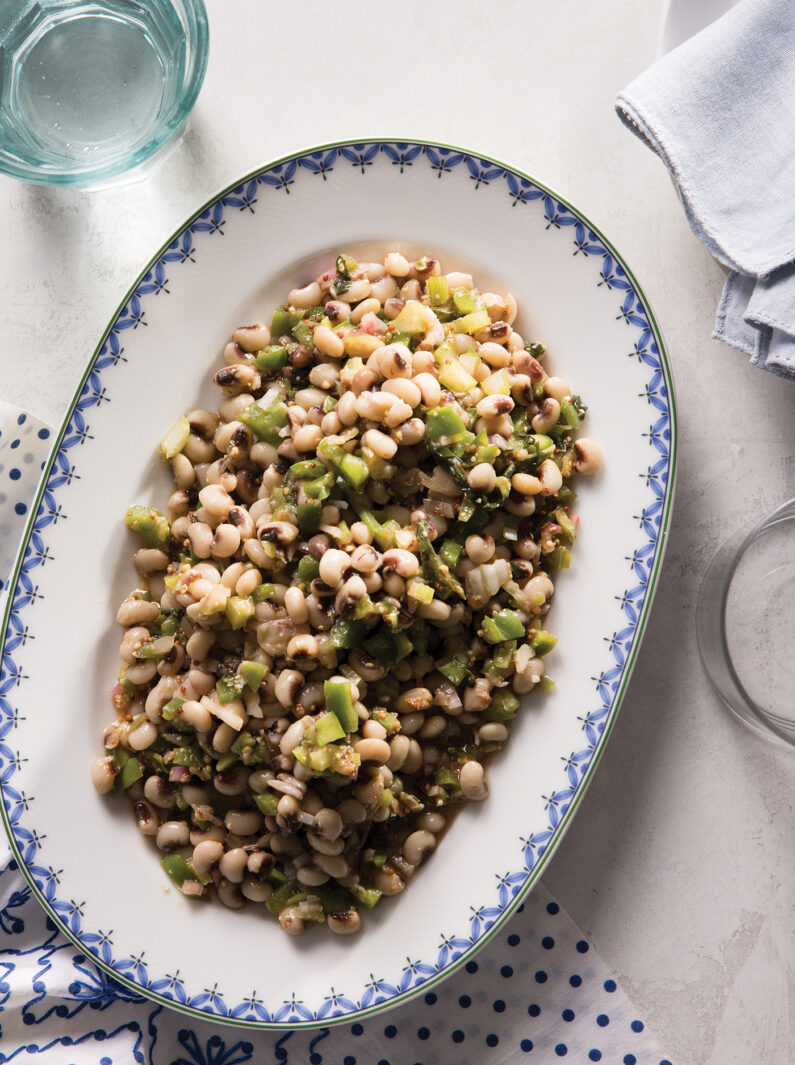
Spicy Mustard Field Pea Salad
Serves 4
3 cups fresh or frozen pinkeye
purple hull field peas (about 1 pound)
1/3 cup extra virgin olive oil
1/4 cup apple cider vinegar
1/2 cup finely chopped celery
1/4 cup finely chopped red onion
1 large sweet pepper, finely chopped
3 tablespoons coarse, whole grain mustard
1/2 cup snipped fresh basil
1/2 teaspoon smoked paprika
1/2 teaspoon sea salt
1. In a 2-quart saucepan, cover peas with water and bring to boil. Reduce heat to low and simmer uncovered for about 25 minutes or until tender. Avoid stirring to keep skins intact.
2. In a medium mixing bowl, add the rest of the ingredients and whisk until combined.
3. After peas have reached desired tenderness, drain and let cool slightly in a shallow mixing bowl.
4. While still a little warm, toss peas with all remaining ingredients and chill in fridge at least one hour.
*Cook’s note: Keep in mind that immersion in vinaigrette will firm up the texture of the peas, so it’s preferable for them to be more
tender than not.
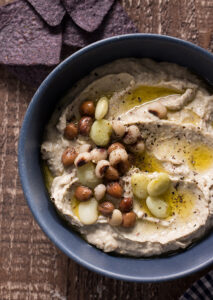
Three-Pea Hummus
Serves 6
1 cup cooked speckled butter beans
1 cup cooked crowder peas
1 cup cooked pink eye purple hull peas
3 cloves garlic
1/3 cup tahini
1 teaspoon salt
1/2 teaspoon black pepper
Pinch cayenne
3/4 cup extra virgin olive oil
1/4 cup fresh lemon juice
1. In the bowl of a food processor, combine peas, garlic, tahini, salt, pepper and cayenne. Pulse until mixture is finely chopped.
2. Add olive oil and lemon juice and puree to a smooth texture.
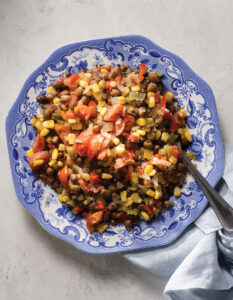
Field Pea Succotash
Serves 4
1/2 large onion, finely diced
1 cup diced green bell pepper
1 cup diced red bell pepper
3 tablespoons olive oil
1/4 cup grape tomatoes, quartered
2 cups frozen corn kernels
2 cups cooked crowder peas
1/2 cup reserved liquid from cooked peas
1 tablespoon fresh thyme leaves, finely chopped
1/2 teaspoon salt
1/2 cup sliced green onions
1. In a large skillet, saute onion and bell peppers in olive oil over medium heat, about 5 to 7 minutes, or until tender.
2. Stir in corn and crowder peas. Cook 2 minutes or until thoroughly heated.
3. Stir in reserved crowder pea liquid, thyme and salt. Cook 1 to 2 minutes or until thoroughly heated.
4. Garnish with green onions and serve immediately.
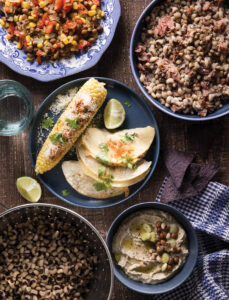
Classic Southern Peas
Serves 3
2 smoked ham hocks
1 1/2 cups finely chopped onion
3 tablespoons bacon drippings
2 garlic cloves, minced
3 cups shelled fresh pinkeye purple hull peas (about 1 pound)
1 teaspoon kosher salt
1 teaspoon ground black pepper
1. In a large pot, bring ham hocks and 2 quarts water to a boil over medium heat. Simmer 1 1/2 to 2 hours or until meat is tender.
2. While ham hocks are boiling, in a medium skillet, saute onion in bacon drippings over medium-high heat for about 6 minutes or until onion is translucent. Add garlic and saute 1 minute more.
3. Add peas and onion mixture to the pot with ham hocks. Bring to a simmer over medium heat. Cover and simmer, stirring occasionally, for 20 minutes, or until peas reach desired tenderness.
4. Remove hocks from liquid and place on a cutting board. Drain peas, and sprinkle with salt and pepper, adjusting for desired flavor.
5. Chop ham from bones. Stir ham into peas and serve.
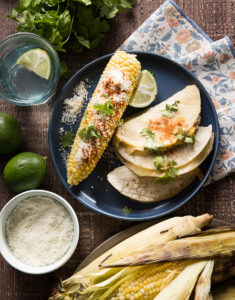
Butter Bean Quesadillas
Serves 5
2 cups cooked speckled butter beans
1/2 teaspoon salt
1/4 teaspoon cumin
1/4 teaspoon onion powder
1/4 teaspoon garlic powder
1/4 teaspoon smoked paprika
1/8 teaspoon chili powder
1/2 cup caramelized red onion
1/4 cup mayonnaise
2 blocks white sharp cheddar cheese, grated
10 corn tortillas
1. In a medium mixing bowl, mash butter beans with salt, cumin, onion powder, garlic powder, smoked paprika and chili powder until a paste forms. Add caramelized onions and mayonnaise. Mix until fully combined.
2. On a corn tortilla, add a spoonful of mixture to one side. Top with cheese. Close and press gently. Place tortilla in a small skillet over medium heat until browned. Flip and brown other side.
3. Remove quesadilla and repeat until mixture or tortillas are used.





